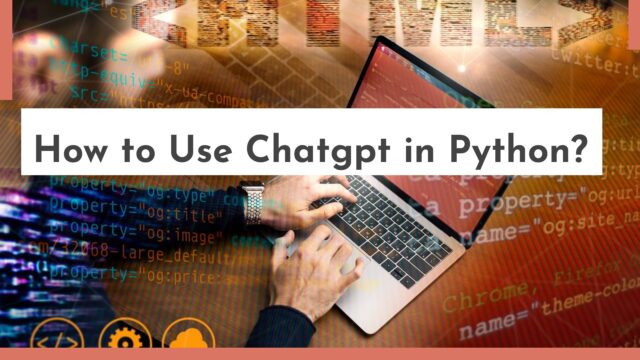In today’s tech-driven world, AI models like ChatGPT are taking center stage, automating various aspects of our lives using Python. Chatbots, particularly those created with Python, have become essential tools, and ChatGPT is a powerful player in this space. This article is your go-to guide on “how to use ChatGPT in Python” Before we dive into the practicalities, let’s take a quick look at what ChatGPT is and why it’s so widely used. Get ready for a straightforward exploration of ChatGPT’s applications and a simple step-by-step guide on incorporating it into your Python projects.
What is ChatGPT API?
Using the ChatGPT API, an interface provided by OpenAI, developers can include the ChatGPT model into their own programs, platforms, or applications. With it, programmers can submit a prompt, use an API to access the ChatGPT model, and receive a response depending on the model. Developers can leverage ChatGPT’s conversational capabilities by integrating natural language production and processing elements into their services, products, or apps through the ChatGPT API.
Using OpenAI API for ChatGPT in Python
Integrating ChatGPT into Python applications is made easy with the OpenAI API. This guide explores the process and provides code snippets for better understanding.
Get OpenAI API Key
- Sign up for an OpenAI account.
- Obtain your API key from the provided link after creating an account.
Install openai Package
Ensure you have pip installed:
bashCopy code
pip --version
If not installed, run:
bashCopy code
python -m ensurepip --upgrade
Install openai and pandas:
bashCopy code
pip install pandas openai
Import openai Module
pythonCopy code
import openai
Generate ChatGPT Response
Use the openai library to create a response function:
pythonCopy code
import openai openai.api_key = "YOUR_API_KEY" def generate_response(prompt): model_engine = "text-davinci-003" prompt = (f"{prompt}") completions = openai.Completion.create( engine=model_engine, prompt=prompt, max_tokens=1024, n=1, stop=None, temperature=0.5, ) message = completions.choices[0].text return message.strip()
Choose Model Engine
For the demo, we use the “text-davinci-003” model engine. Different models cater to varying task complexities.
Integrating ChatGPT API with Python
OpenAI’s ChatGPT API provides developers with the ability to seamlessly integrate the powerful ChatGPT model into their applications, enabling natural language processing and generation features. This comprehensive guide walks you through the essential steps to successfully use the ChatGPT API in Python.
Step-by-Step ChatGPT API Integration Guide
1. Create API Key
- Visit the OpenAI API Key page.
- Click on ‘Create new secret key’ to generate a unique access code for API communication.
2. Install OpenAI Library
To leverage the ChatGPT API in Python, install the necessary ‘openai’ library. Run the following command:
bashCopy code
pip install openai
3. Install Other Necessary Libraries
Depending on your specific use case, install any additional libraries required for your intended functionality.
4. Set Your API Key
In your Python script, set the API key obtained in the first step for authentication:
pythonCopy code
import openai openai.api_key = '<YOUR API KEY>'
5. Define a Function for ChatGPT Interaction
Create a Python function that interacts with ChatGPT and retrieves responses. Here’s a sample function:
pythonCopy code
def get_completion(prompt, model="gpt-3.5-turbo"): messages = [{"role": "user", "content": prompt}] response = openai.ChatCompletion.create(model=model, messages=messages, temperature=0) return response.choices[0].message["content"]
6. Query the API
Utilize the defined function to interact with ChatGPT and obtain responses:
pythonCopy code
prompt = "<YOUR QUERY>" response = get_completion(prompt) print(response)
ChatGPT API Pricing
As of the latest information, the gpt-3.5-turbo model is available at $0.002 per 1,000 tokens. This model, designed specifically for dialogue, is significantly more cost-effective compared to the original text-davinci-003 model. The cost reduction enhances accessibility, making ChatGPT API integration feasible for applications with diverse budget constraints.
For the most up-to-date pricing details, refer to OpenAI’s official documentation.
Customizing ChatGPT Responses
Adjust the temperature parameter to influence response diversity. Higher values yield more varied responses, while lower values provide more predictable ones.
Example Chatbot Application
Use the generate_response() function in a simple chatbot:
pythonCopy code
while True: user_input = input("User: ") if user_input == "exit": break response = generate_response(user_input) print("Chatbot:", response)
The chatbot continues generating responses until the user inputs “exit.”
Bonus Method
Bonus Tip On How to Use ChatGPT in Python
Prerequisites
Ensure Python and pip (Python package manager) are installed on your system before proceeding.
Library Installation
Open a terminal or command prompt and execute the following command to install the OpenAI API client library:
bashCopy code
$ pip install openai
This command installs the OpenAI API client along with its dependencies.
Importing the Library
In your Python script, include the following line at the top to import the OpenAI library:
pythonCopy code
import openai
Setting Up OpenAI API Client
Configure the OpenAI API client by setting your API key:
pythonCopy code
openai.api_key = "YOUR_API_KEY"
Replace “YOUR_API_KEY” with your actual API key obtained from the OpenAI website.
Interacting with OpenAI
Extend your Python code to interact with OpenAI using the client library. For example:
pythonCopy code
import openai # Set up the OpenAI API client openai.api_key = "YOUR_API_KEY" # Set up the model and prompt model_engine = "text-davinci-003" prompt = "Hello, how are you today?" # Generate a response completion = openai.Completion.create( engine=model_engine, prompt=prompt, max_tokens=1024, n=1, stop=None, temperature=0.5, ) response = completion.choices[0].text print(response)
Customize the model behavior using parameters like temperature for randomness control and stop to limit generated text length or filter inappropriate content.
API Key Setup
Replace “YOUR_API_KEY” with your actual API key obtained by signing up on the OpenAI website. This ensures authentication for API requests.
Testing the Script
Execute the Python script in the command line:
bashCopy code
$ python chat.py
Check the generated response from ChatGPT based on the provided prompt.
This step-by-step guide facilitates the installation and utilization of the OpenAI API client library for Python.
Conclusion
To sum it up, now that you’ve learned “how to use ChatGPT in Python,” you’ve gained a valuable skill for making your projects more interactive and engaging. With its simplicity and versatility, integrating ChatGPT into your Python applications is a game-changer. So, go ahead, apply what you’ve learned, and enjoy the enhanced conversational features in your coding endeavors.
Also, check out:









